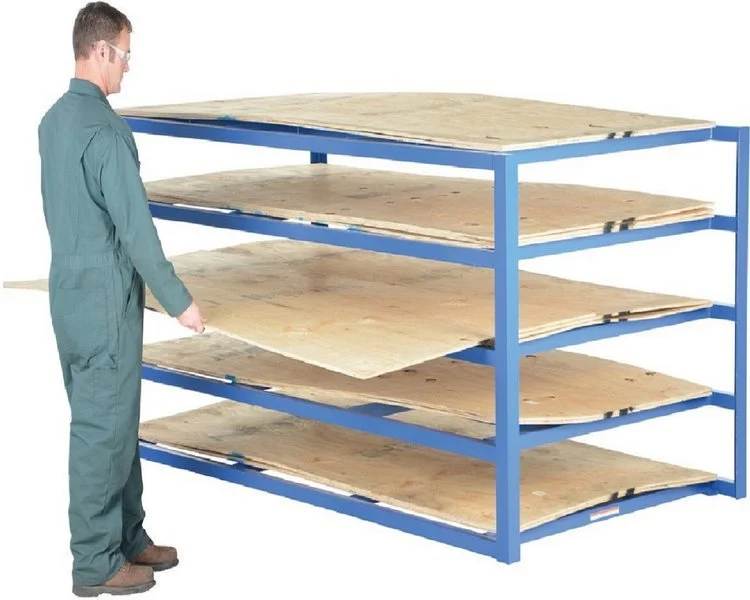Believe it or not, there are a lot of factors to consider when choosing a rolling ladder for your warehouse or workspace. Not all rolling ladders are the same. In fact, customizable industrial rolling ladders come in a variety of sizes and include various features to make them ideal for nearly any use. Below we will explore the definition of a rolling ladder, some advantages to rolling ladders, and how to choose the right one for your workspace.
Defining “Rolling Ladder”
Generally, rolling ladders are safer than a typical ladder, as they are equipped with wider steps, a more gradual incline, and railings that make them feel more like moveable stairs than a ladder. These types of rolling ladders include wheels attached to the bottom so users can easily relocate them to any area of a warehouse or stockroom. These wheels will also have the ability to lock in place so the ladder doesn’t shift while in use. Rolling ladders are often used in industrial and commercial capacities, helping employees safely reach items from high shelves.
Rolling ladders are usually made from corrosion-resistant metal and can be designated for indoor or outdoor use. They must meet OSHA safety standards and may include specialized non-slip stairs suitable for a variety of workplace environments. Rolling ladders for commercial use must meet specific design requirements, plus be inspected and maintained before and during company use. Employees who utilize rolling ladders at their places of work must complete training on rolling ladder operation and safety before securing authorization to use.
Some rolling ladders are constructed with a gradual 50 degree incline for both maximum use of space and optimal safety when carrying heavy loads up and down. This specific incline allows users to face either direction when ascending or descending the steps.
Rolling ladders can include only a few steps all the way up to a 15 depending on the specific needs of the business. The platform of a rolling ladder will ideally be 6 to 7 feet below the lowest point of the ceiling (or anything hanging from the ceiling) in the workspace to allow for ample room for maneuverability at the top.
Rolling ladders assist with daily operations in warehouses, storerooms, and other business settings by allowing safe access to anything located above a normal range of grip. With rolling ladders, companies can exercise maximum use of overhead space, increase their efficiency in their daily operations, and save money with an alternative to more expensive machinery. Rolling ladders are not just convenient to many businesses, but essential to everyday operations.
Advantages to Rolling Ladders
Rolling ladders offer several advantages over regular ladders and can be used for a variety of purposes. From cleaning the tops of vehicles, to reaching items on high shelves, to providing a tall platform for maintenance needs, rolling ladders are useful in a variety of settings. Regular ladders may be compact and easy to store, but they do have their limitations. Listed below are a few advantages to using rolling ladders in an industrial setting.
Portability and Storage
Instead of constructing permanent climbing structures or stairs everywhere needed in a warehouse, rolling ladders provide necessary accessibility anywhere you can move them. The wheels on portable ladders make it easy to relocate a rolling ladder without having to fold and unfold a ladder every time you require a location change. Some rolling ladder designs are even collapsible to help users easily store when finished with their work.
Safe to Use
The safety benefits of rolling ladders are endless. Rolling ladders offer more stability than traditional ladders, as they are less likely to tip over when someone is one them and they are easier to climb. Since the incline is gradual, they feel more like regular stairs than a ladder. Rolling ladders also can come equipped with handrails for increased safety at tall heights. Rolling ladders must meet OSHA standards to keep employees safe and reduce risk of falls in the workplace.
Companies can choose specific stair types for their rolling ladders to best fit their safety requirements during use. For instance, expanded metal tread stairs look more like a grate and allow for dust and debris to fall through the holes to help keep the stairs cleaner in dustier environments. Perforated and serrated tread provide the most grip and slip resistance—best for wet environments or environments that are prone to spills. Abrasive mat stairs also provide slip resistance, but are better for work environments with low amounts of dirt such as an indoor office.
Variety of Applications
Rolling ladders can be used in a variety of business settings. Not only can companies use rolling ladders for easy storage accessibility, but they can be used to help workers clean machinery, wash company trucks, clean movie theater screens, and even feed animals at zoos. Rolling ladders can be an invaluable asset to many industries and businesses.
Choosing the Right Rolling Ladder for Your Workspace
At Platforms and Ladders, we offer a variety of rolling ladders to choose from for your business. With multiple customization available, there are at least 50 different combinations possible to create the very best rolling ladder for the needs of your particular business. When choosing a rolling ladder for your company, there are a few factors to take into consideration. Learn more about our rolling ladder options below to help you find the best ladder for your business.
Size
The most important factor when picking out a rolling ladder for your business is size needed. What will you primarily be using the ladder for and how tall does it need to be for workers to reach what they need? Remember, the platform should ideally be at least 6 to 7 feet below the lowest hanging item from the ceiling, or maximum 5 to 6 feet below the working height. For truck access ladders, the platform should be at or just below the bed of the truck.
Not only does height matter, but width does as well. For narrow spaces, a narrower rolling ladder may fit the space better. For transporting heavier loads, a wider ladder may be a more stable platform for the workers to lift what they need. Think about maneuverability in and around the space where you will be using the ladder. Will you need it to go through doorways or around any stationary objects? Think also of where you will store the ladder when not in use. Does it need to be collapsible or can it stay put in an open area?
Wheel Locking Mechanisms
Rolling ladders have different wheel designs and mechanisms for keeping the ladder in place when in use. Some ladders have wheels on one side and legs on the other, where users can move them like a wheelbarrow. When they are set down, the legs help them stay in place. Other designs include wheels on every side with a step or handle locking mechanism to lock the wheels once the ladder is in place. These rolling ladders can be moved without having to tilt them, and may also include swivel casters for greater range of motion when moving about.
Extra Storage Needs
A few of the larger ladder designs include shelving underneath the steps to help transport inventory with the ladder and keep inventory out of the way when stocking shelves. These ladders include a greater weight capacity to handle the extra weight of the inventory.
People Primarily Using Ladder
Last, but not least, you may consider the people who will primarily be using the rolling ladder and what their needs are to help make the most use out of the equipment. Many rolling ladders have weight capacities to consider for both the user and stock being carried. Also, will all your workers be able to tilt a tilt and roll ladder or will a different design be necessary? What type of step grip best fits the needs and environment of your warehouse? Thinking through all of these factors will help you find a ladder that is not only functional for your team but safe as well.






























